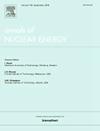The two point Feynman-α theory: Theory and practice of Ex-Core reactor noise measurement
IF 1.9
3区 工程技术
Q1 NUCLEAR SCIENCE & TECHNOLOGY
引用次数: 0
Abstract
The Feynman- method is a widely used realization of the so-called ”reactor noise” theory, where static and kinetic parameters of the core are estimated by sampling statistical properties of the neutron count distribution in a critical or subcritical configuration. In the Feynman- method, the variance-to-mean ratio (as a function of the detection gate) is sampled, and then the eigenvalue is estimated through a standard fitting procedure. The theory behind the Feynman- method relies on a single-group analysis. From a practical point of view, the single group model requires that the detector be located within or next to the reactor core.
Implementation of the Feynman- method is simple and robust due to three facts: first, although the dynamics are determined by (at least) 5 parameters, the fit is done only for a two-parameter function. Second, these parameters are well separated: one is a constant multiplier and the second is an exponential coefficient. Third, the exponential coefficient has a clear and simple physical interpretation, which can be easily used to estimate the reactivity of the core. In the past decade, the classic Feynman- theory has been extended to a multi-group setting, using the probability generating function formalism. However, in the resulting formulas, it seems, the above mentioned properties are often lost: implementation would require a fit on a multi-exponential function, whose decay modes are defined by the eigenvalues of a certain ”reaction rate” matrix, which may not be explicitly computed, and would depend on parameters that cannot be calibrated in a simple manner.
The present study introduces a simple two-group model, for two distinct spatial regions: the core region and the moderator/reflector region. It assumes that the detector is located outside the core, within the moderator/reflector region. Through direct analysis of the reaction rate matrix, we address the practical applications of the two-point Feynman- theory: when should we expect a good ”separation” between the different decay modes, and when would the reactivity be tractable from standard fitting procedure. This study starts with the theoretical derivation, then we first conduct a numeric study to verify the conditions for applying the two region model, and second we use the two region model to revisit Ex-Core noise experiments conducted the IPEM/MB-01 and the CROCUS reactors.
求助全文
约1分钟内获得全文
求助全文
来源期刊

Annals of Nuclear Energy
工程技术-核科学技术
CiteScore
4.30
自引率
21.10%
发文量
632
审稿时长
7.3 months
期刊介绍:
Annals of Nuclear Energy provides an international medium for the communication of original research, ideas and developments in all areas of the field of nuclear energy science and technology. Its scope embraces nuclear fuel reserves, fuel cycles and cost, materials, processing, system and component technology (fission only), design and optimization, direct conversion of nuclear energy sources, environmental control, reactor physics, heat transfer and fluid dynamics, structural analysis, fuel management, future developments, nuclear fuel and safety, nuclear aerosol, neutron physics, computer technology (both software and hardware), risk assessment, radioactive waste disposal and reactor thermal hydraulics. Papers submitted to Annals need to demonstrate a clear link to nuclear power generation/nuclear engineering. Papers which deal with pure nuclear physics, pure health physics, imaging, or attenuation and shielding properties of concretes and various geological materials are not within the scope of the journal. Also, papers that deal with policy or economics are not within the scope of the journal.
 求助内容:
求助内容: 应助结果提醒方式:
应助结果提醒方式:


